Economic Analysis: Evaluating Australia's Federal Budget 2018-19
VerifiedAdded on 2023/06/03
|22
|5022
|302
Report
AI Summary
This report provides a comprehensive analysis of the Australian Federal Budget for the financial year 2018-19, focusing on strategies to achieve a stronger economy through fiscal management, revenue improvement, and support for business investment. It examines the global and domestic economic outlook, including GDP growth, unemployment, and inflation, and offers recommendations to strengthen Australia's economic condition. The budget's key components, such as tax relief, business support, and essential service provision, are evaluated in relation to the government's goal of achieving a budget surplus by 2020-21. The report also emphasizes the importance of controlling government spending and reducing debt to ensure sustainable economic growth.
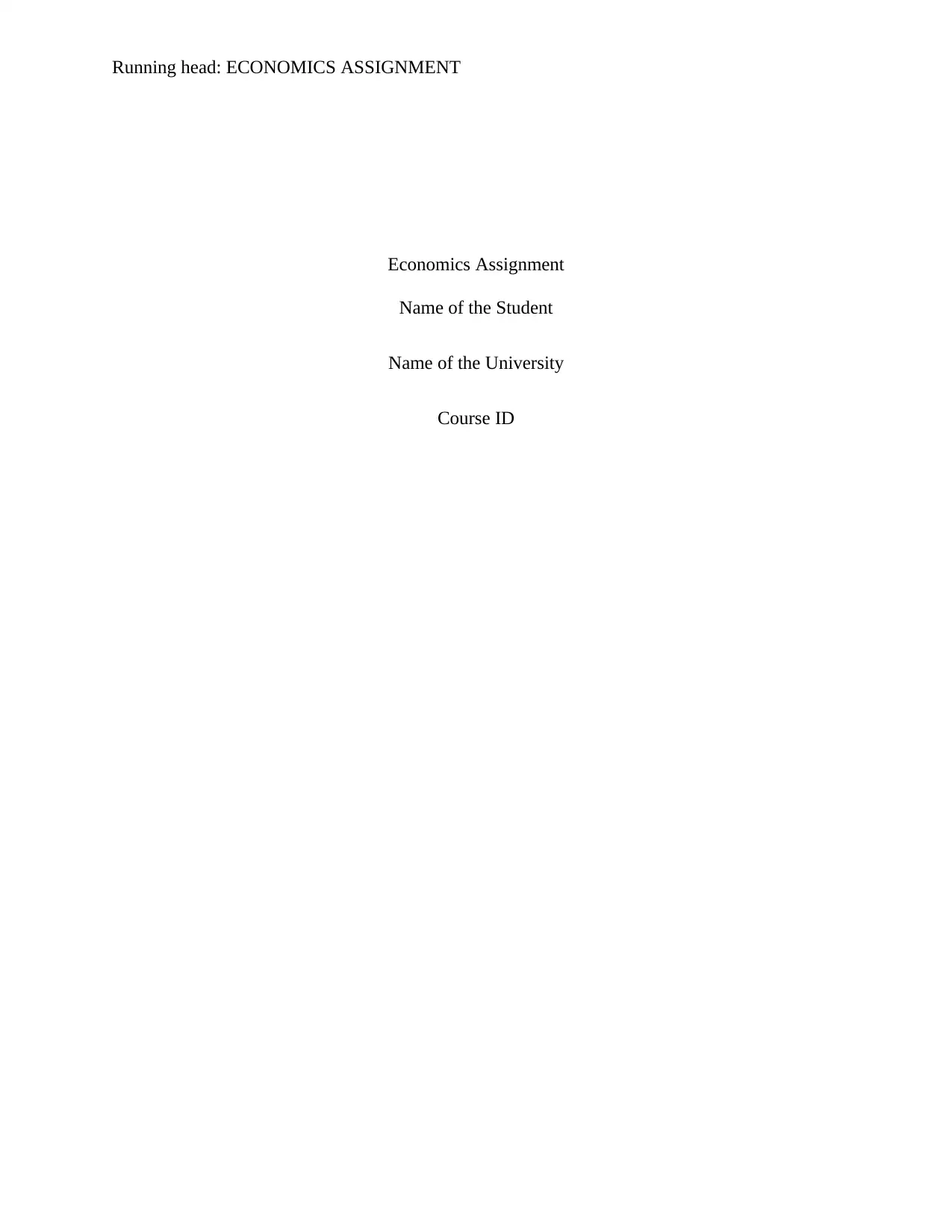
Running head: ECONOMICS ASSIGNMENT
Economics Assignment
Name of the Student
Name of the University
Course ID
Economics Assignment
Name of the Student
Name of the University
Course ID
Paraphrase This Document
Need a fresh take? Get an instant paraphrase of this document with our AI Paraphraser
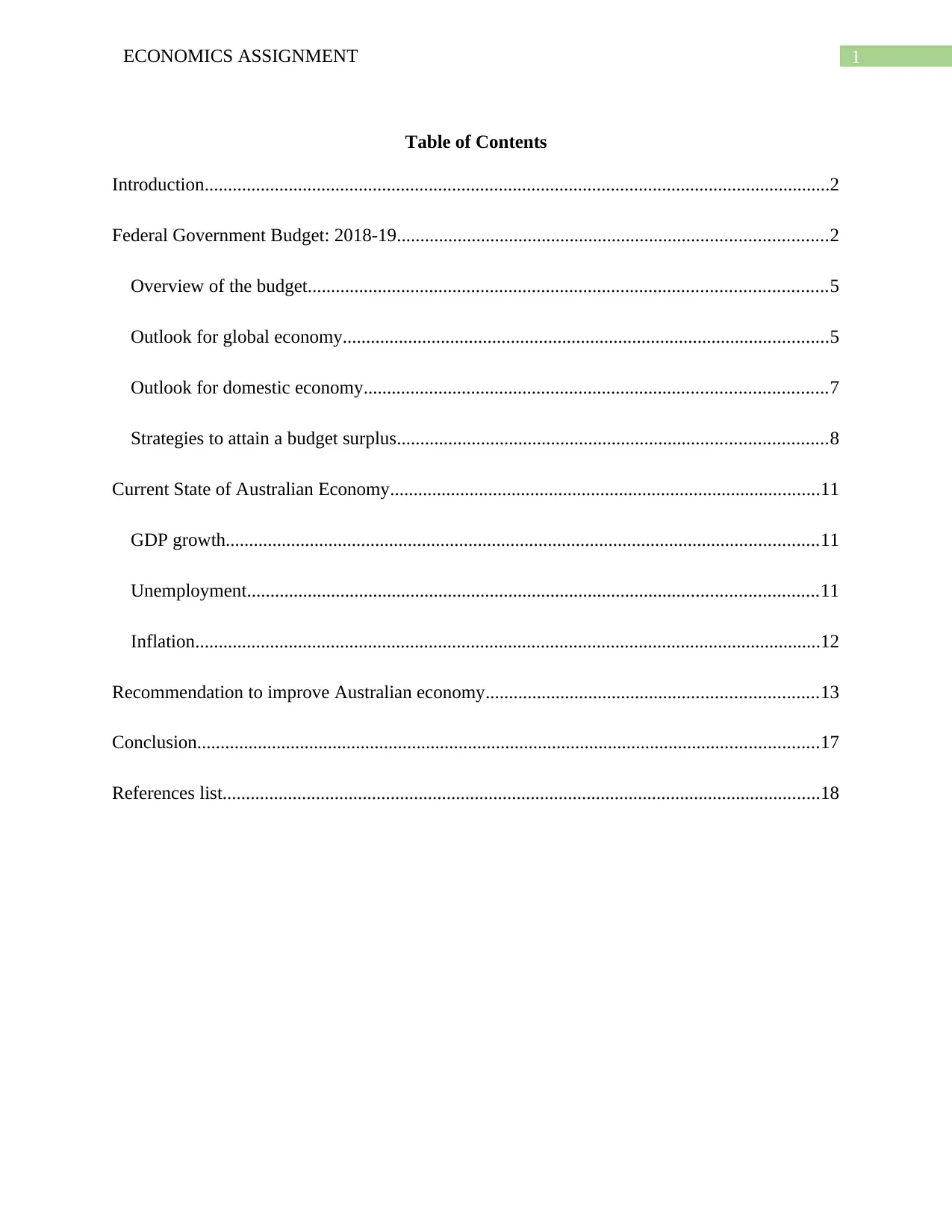
1ECONOMICS ASSIGNMENT
Table of Contents
Introduction......................................................................................................................................2
Federal Government Budget: 2018-19............................................................................................2
Overview of the budget...............................................................................................................5
Outlook for global economy........................................................................................................5
Outlook for domestic economy...................................................................................................7
Strategies to attain a budget surplus............................................................................................8
Current State of Australian Economy............................................................................................11
GDP growth...............................................................................................................................11
Unemployment..........................................................................................................................11
Inflation......................................................................................................................................12
Recommendation to improve Australian economy.......................................................................13
Conclusion.....................................................................................................................................17
References list................................................................................................................................18
Table of Contents
Introduction......................................................................................................................................2
Federal Government Budget: 2018-19............................................................................................2
Overview of the budget...............................................................................................................5
Outlook for global economy........................................................................................................5
Outlook for domestic economy...................................................................................................7
Strategies to attain a budget surplus............................................................................................8
Current State of Australian Economy............................................................................................11
GDP growth...............................................................................................................................11
Unemployment..........................................................................................................................11
Inflation......................................................................................................................................12
Recommendation to improve Australian economy.......................................................................13
Conclusion.....................................................................................................................................17
References list................................................................................................................................18
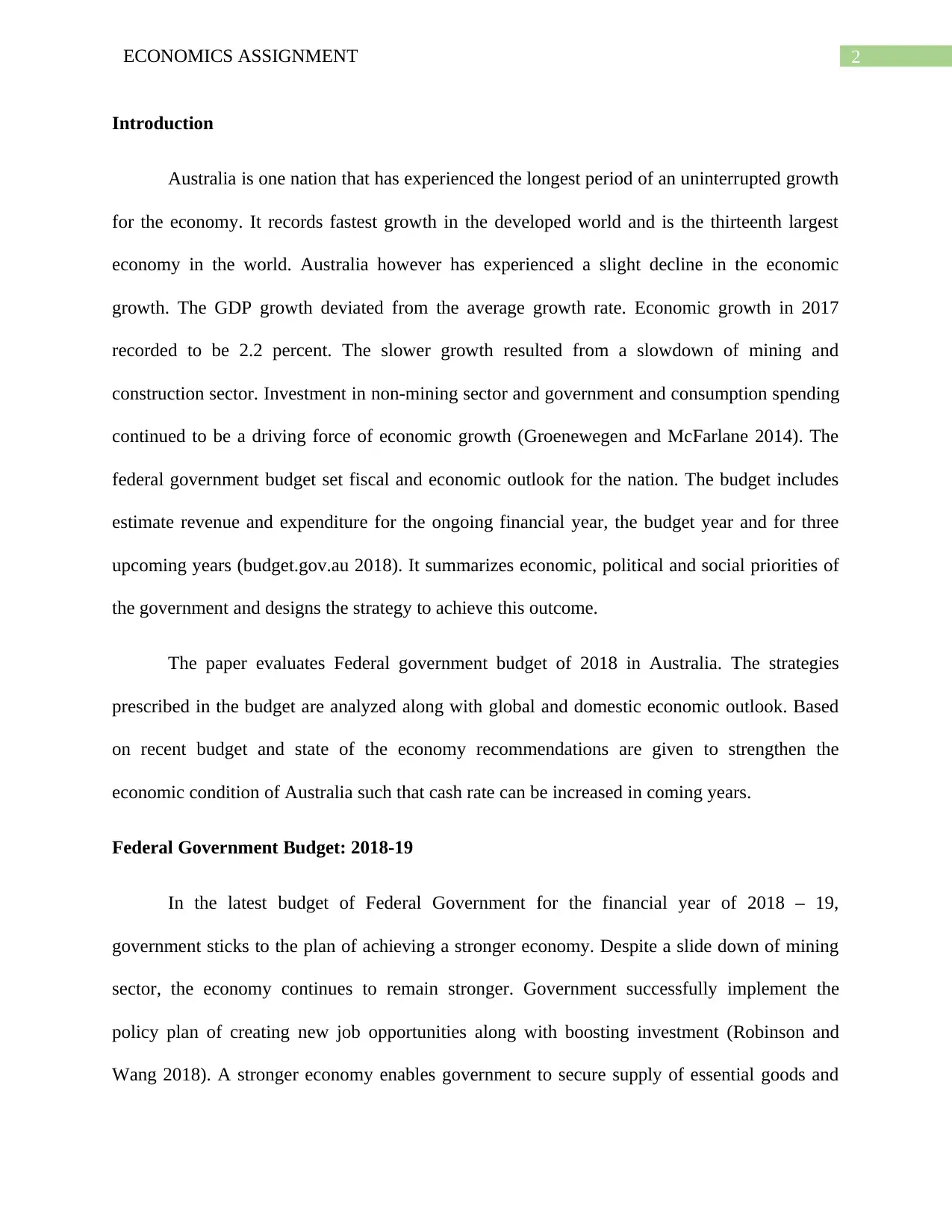
2ECONOMICS ASSIGNMENT
Introduction
Australia is one nation that has experienced the longest period of an uninterrupted growth
for the economy. It records fastest growth in the developed world and is the thirteenth largest
economy in the world. Australia however has experienced a slight decline in the economic
growth. The GDP growth deviated from the average growth rate. Economic growth in 2017
recorded to be 2.2 percent. The slower growth resulted from a slowdown of mining and
construction sector. Investment in non-mining sector and government and consumption spending
continued to be a driving force of economic growth (Groenewegen and McFarlane 2014). The
federal government budget set fiscal and economic outlook for the nation. The budget includes
estimate revenue and expenditure for the ongoing financial year, the budget year and for three
upcoming years (budget.gov.au 2018). It summarizes economic, political and social priorities of
the government and designs the strategy to achieve this outcome.
The paper evaluates Federal government budget of 2018 in Australia. The strategies
prescribed in the budget are analyzed along with global and domestic economic outlook. Based
on recent budget and state of the economy recommendations are given to strengthen the
economic condition of Australia such that cash rate can be increased in coming years.
Federal Government Budget: 2018-19
In the latest budget of Federal Government for the financial year of 2018 – 19,
government sticks to the plan of achieving a stronger economy. Despite a slide down of mining
sector, the economy continues to remain stronger. Government successfully implement the
policy plan of creating new job opportunities along with boosting investment (Robinson and
Wang 2018). A stronger economy enables government to secure supply of essential goods and
Introduction
Australia is one nation that has experienced the longest period of an uninterrupted growth
for the economy. It records fastest growth in the developed world and is the thirteenth largest
economy in the world. Australia however has experienced a slight decline in the economic
growth. The GDP growth deviated from the average growth rate. Economic growth in 2017
recorded to be 2.2 percent. The slower growth resulted from a slowdown of mining and
construction sector. Investment in non-mining sector and government and consumption spending
continued to be a driving force of economic growth (Groenewegen and McFarlane 2014). The
federal government budget set fiscal and economic outlook for the nation. The budget includes
estimate revenue and expenditure for the ongoing financial year, the budget year and for three
upcoming years (budget.gov.au 2018). It summarizes economic, political and social priorities of
the government and designs the strategy to achieve this outcome.
The paper evaluates Federal government budget of 2018 in Australia. The strategies
prescribed in the budget are analyzed along with global and domestic economic outlook. Based
on recent budget and state of the economy recommendations are given to strengthen the
economic condition of Australia such that cash rate can be increased in coming years.
Federal Government Budget: 2018-19
In the latest budget of Federal Government for the financial year of 2018 – 19,
government sticks to the plan of achieving a stronger economy. Despite a slide down of mining
sector, the economy continues to remain stronger. Government successfully implement the
policy plan of creating new job opportunities along with boosting investment (Robinson and
Wang 2018). A stronger economy enables government to secure supply of essential goods and
⊘ This is a preview!⊘
Do you want full access?
Subscribe today to unlock all pages.

Trusted by 1+ million students worldwide
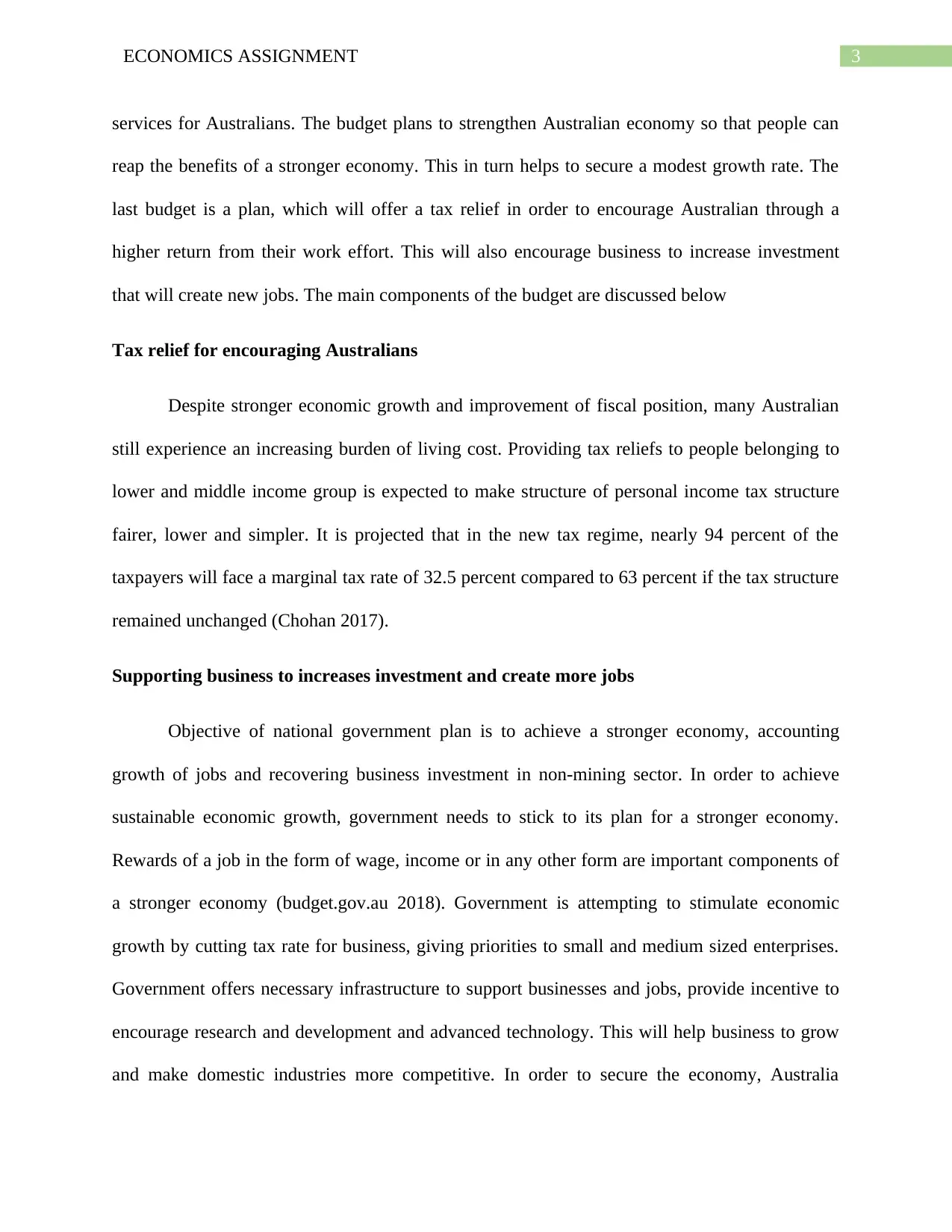
3ECONOMICS ASSIGNMENT
services for Australians. The budget plans to strengthen Australian economy so that people can
reap the benefits of a stronger economy. This in turn helps to secure a modest growth rate. The
last budget is a plan, which will offer a tax relief in order to encourage Australian through a
higher return from their work effort. This will also encourage business to increase investment
that will create new jobs. The main components of the budget are discussed below
Tax relief for encouraging Australians
Despite stronger economic growth and improvement of fiscal position, many Australian
still experience an increasing burden of living cost. Providing tax reliefs to people belonging to
lower and middle income group is expected to make structure of personal income tax structure
fairer, lower and simpler. It is projected that in the new tax regime, nearly 94 percent of the
taxpayers will face a marginal tax rate of 32.5 percent compared to 63 percent if the tax structure
remained unchanged (Chohan 2017).
Supporting business to increases investment and create more jobs
Objective of national government plan is to achieve a stronger economy, accounting
growth of jobs and recovering business investment in non-mining sector. In order to achieve
sustainable economic growth, government needs to stick to its plan for a stronger economy.
Rewards of a job in the form of wage, income or in any other form are important components of
a stronger economy (budget.gov.au 2018). Government is attempting to stimulate economic
growth by cutting tax rate for business, giving priorities to small and medium sized enterprises.
Government offers necessary infrastructure to support businesses and jobs, provide incentive to
encourage research and development and advanced technology. This will help business to grow
and make domestic industries more competitive. In order to secure the economy, Australia
services for Australians. The budget plans to strengthen Australian economy so that people can
reap the benefits of a stronger economy. This in turn helps to secure a modest growth rate. The
last budget is a plan, which will offer a tax relief in order to encourage Australian through a
higher return from their work effort. This will also encourage business to increase investment
that will create new jobs. The main components of the budget are discussed below
Tax relief for encouraging Australians
Despite stronger economic growth and improvement of fiscal position, many Australian
still experience an increasing burden of living cost. Providing tax reliefs to people belonging to
lower and middle income group is expected to make structure of personal income tax structure
fairer, lower and simpler. It is projected that in the new tax regime, nearly 94 percent of the
taxpayers will face a marginal tax rate of 32.5 percent compared to 63 percent if the tax structure
remained unchanged (Chohan 2017).
Supporting business to increases investment and create more jobs
Objective of national government plan is to achieve a stronger economy, accounting
growth of jobs and recovering business investment in non-mining sector. In order to achieve
sustainable economic growth, government needs to stick to its plan for a stronger economy.
Rewards of a job in the form of wage, income or in any other form are important components of
a stronger economy (budget.gov.au 2018). Government is attempting to stimulate economic
growth by cutting tax rate for business, giving priorities to small and medium sized enterprises.
Government offers necessary infrastructure to support businesses and jobs, provide incentive to
encourage research and development and advanced technology. This will help business to grow
and make domestic industries more competitive. In order to secure the economy, Australia
Paraphrase This Document
Need a fresh take? Get an instant paraphrase of this document with our AI Paraphraser
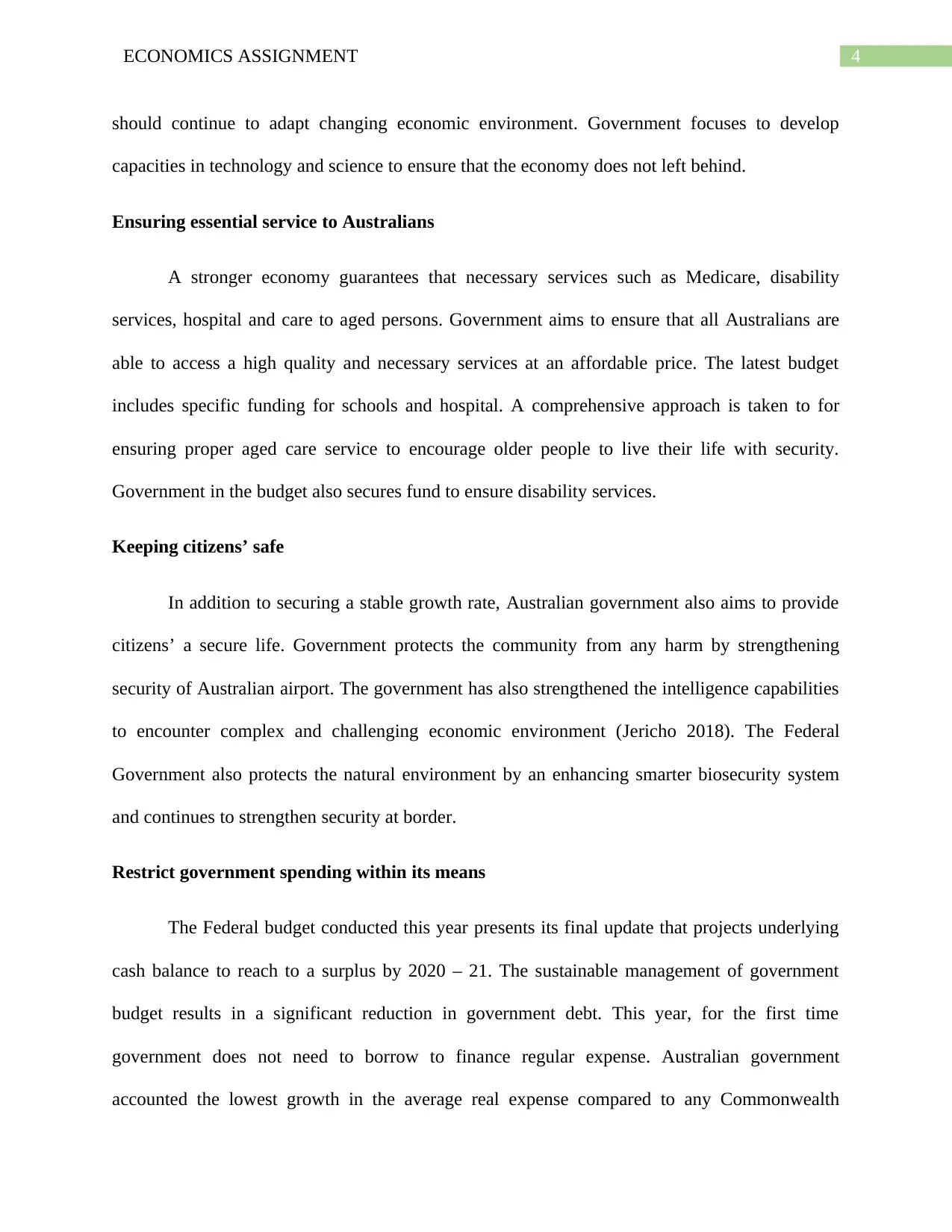
4ECONOMICS ASSIGNMENT
should continue to adapt changing economic environment. Government focuses to develop
capacities in technology and science to ensure that the economy does not left behind.
Ensuring essential service to Australians
A stronger economy guarantees that necessary services such as Medicare, disability
services, hospital and care to aged persons. Government aims to ensure that all Australians are
able to access a high quality and necessary services at an affordable price. The latest budget
includes specific funding for schools and hospital. A comprehensive approach is taken to for
ensuring proper aged care service to encourage older people to live their life with security.
Government in the budget also secures fund to ensure disability services.
Keeping citizens’ safe
In addition to securing a stable growth rate, Australian government also aims to provide
citizens’ a secure life. Government protects the community from any harm by strengthening
security of Australian airport. The government has also strengthened the intelligence capabilities
to encounter complex and challenging economic environment (Jericho 2018). The Federal
Government also protects the natural environment by an enhancing smarter biosecurity system
and continues to strengthen security at border.
Restrict government spending within its means
The Federal budget conducted this year presents its final update that projects underlying
cash balance to reach to a surplus by 2020 – 21. The sustainable management of government
budget results in a significant reduction in government debt. This year, for the first time
government does not need to borrow to finance regular expense. Australian government
accounted the lowest growth in the average real expense compared to any Commonwealth
should continue to adapt changing economic environment. Government focuses to develop
capacities in technology and science to ensure that the economy does not left behind.
Ensuring essential service to Australians
A stronger economy guarantees that necessary services such as Medicare, disability
services, hospital and care to aged persons. Government aims to ensure that all Australians are
able to access a high quality and necessary services at an affordable price. The latest budget
includes specific funding for schools and hospital. A comprehensive approach is taken to for
ensuring proper aged care service to encourage older people to live their life with security.
Government in the budget also secures fund to ensure disability services.
Keeping citizens’ safe
In addition to securing a stable growth rate, Australian government also aims to provide
citizens’ a secure life. Government protects the community from any harm by strengthening
security of Australian airport. The government has also strengthened the intelligence capabilities
to encounter complex and challenging economic environment (Jericho 2018). The Federal
Government also protects the natural environment by an enhancing smarter biosecurity system
and continues to strengthen security at border.
Restrict government spending within its means
The Federal budget conducted this year presents its final update that projects underlying
cash balance to reach to a surplus by 2020 – 21. The sustainable management of government
budget results in a significant reduction in government debt. This year, for the first time
government does not need to borrow to finance regular expense. Australian government
accounted the lowest growth in the average real expense compared to any Commonwealth
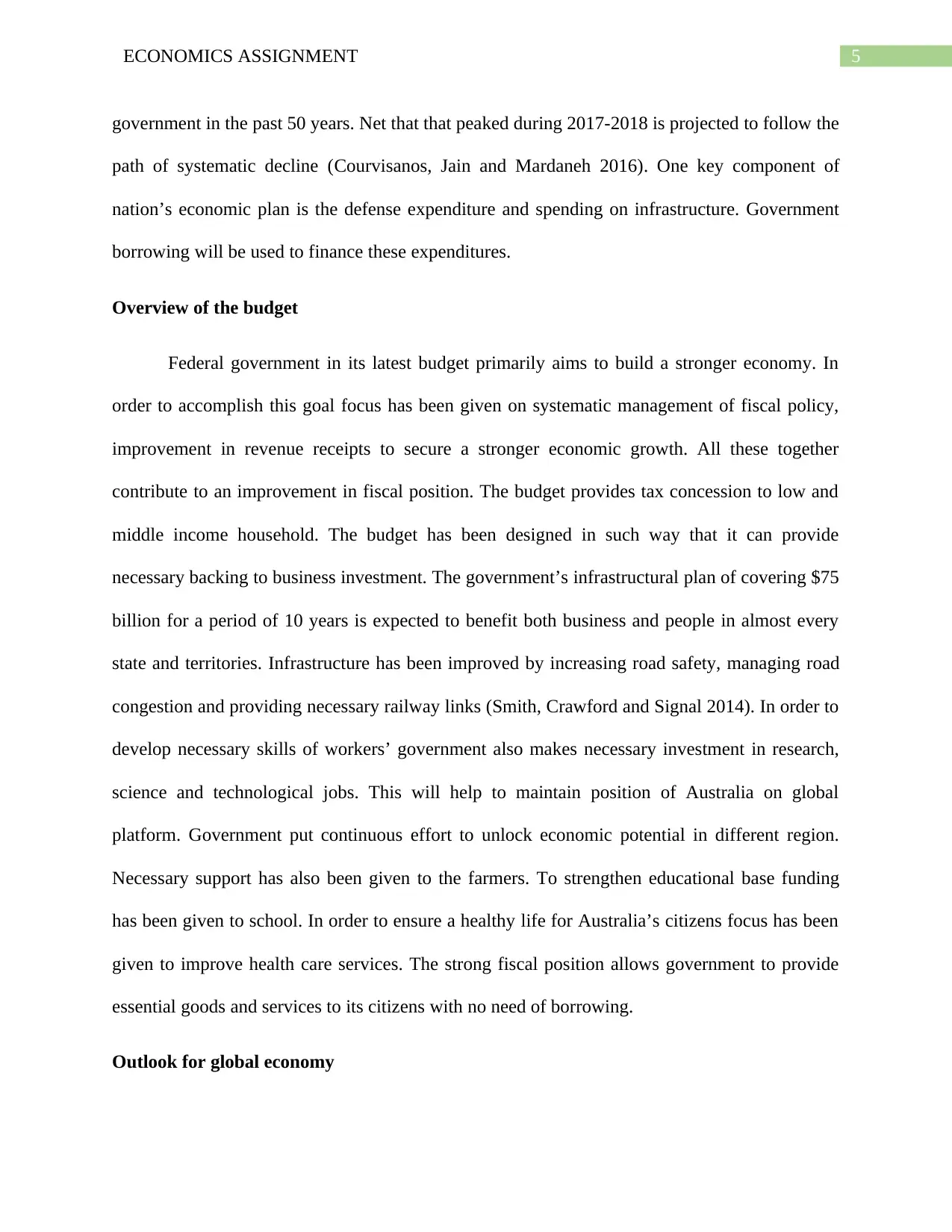
5ECONOMICS ASSIGNMENT
government in the past 50 years. Net that that peaked during 2017-2018 is projected to follow the
path of systematic decline (Courvisanos, Jain and Mardaneh 2016). One key component of
nation’s economic plan is the defense expenditure and spending on infrastructure. Government
borrowing will be used to finance these expenditures.
Overview of the budget
Federal government in its latest budget primarily aims to build a stronger economy. In
order to accomplish this goal focus has been given on systematic management of fiscal policy,
improvement in revenue receipts to secure a stronger economic growth. All these together
contribute to an improvement in fiscal position. The budget provides tax concession to low and
middle income household. The budget has been designed in such way that it can provide
necessary backing to business investment. The government’s infrastructural plan of covering $75
billion for a period of 10 years is expected to benefit both business and people in almost every
state and territories. Infrastructure has been improved by increasing road safety, managing road
congestion and providing necessary railway links (Smith, Crawford and Signal 2014). In order to
develop necessary skills of workers’ government also makes necessary investment in research,
science and technological jobs. This will help to maintain position of Australia on global
platform. Government put continuous effort to unlock economic potential in different region.
Necessary support has also been given to the farmers. To strengthen educational base funding
has been given to school. In order to ensure a healthy life for Australia’s citizens focus has been
given to improve health care services. The strong fiscal position allows government to provide
essential goods and services to its citizens with no need of borrowing.
Outlook for global economy
government in the past 50 years. Net that that peaked during 2017-2018 is projected to follow the
path of systematic decline (Courvisanos, Jain and Mardaneh 2016). One key component of
nation’s economic plan is the defense expenditure and spending on infrastructure. Government
borrowing will be used to finance these expenditures.
Overview of the budget
Federal government in its latest budget primarily aims to build a stronger economy. In
order to accomplish this goal focus has been given on systematic management of fiscal policy,
improvement in revenue receipts to secure a stronger economic growth. All these together
contribute to an improvement in fiscal position. The budget provides tax concession to low and
middle income household. The budget has been designed in such way that it can provide
necessary backing to business investment. The government’s infrastructural plan of covering $75
billion for a period of 10 years is expected to benefit both business and people in almost every
state and territories. Infrastructure has been improved by increasing road safety, managing road
congestion and providing necessary railway links (Smith, Crawford and Signal 2014). In order to
develop necessary skills of workers’ government also makes necessary investment in research,
science and technological jobs. This will help to maintain position of Australia on global
platform. Government put continuous effort to unlock economic potential in different region.
Necessary support has also been given to the farmers. To strengthen educational base funding
has been given to school. In order to ensure a healthy life for Australia’s citizens focus has been
given to improve health care services. The strong fiscal position allows government to provide
essential goods and services to its citizens with no need of borrowing.
Outlook for global economy
⊘ This is a preview!⊘
Do you want full access?
Subscribe today to unlock all pages.

Trusted by 1+ million students worldwide
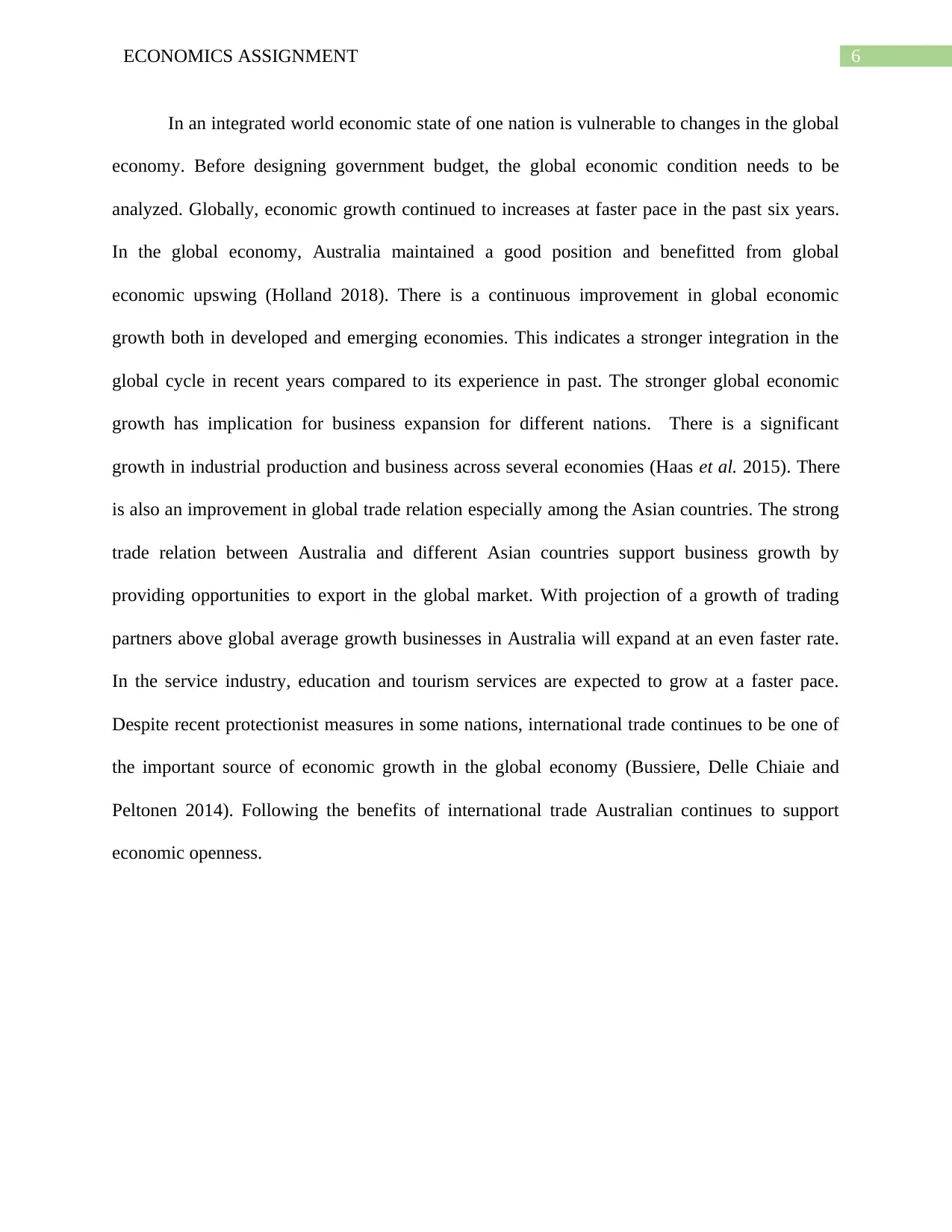
6ECONOMICS ASSIGNMENT
In an integrated world economic state of one nation is vulnerable to changes in the global
economy. Before designing government budget, the global economic condition needs to be
analyzed. Globally, economic growth continued to increases at faster pace in the past six years.
In the global economy, Australia maintained a good position and benefitted from global
economic upswing (Holland 2018). There is a continuous improvement in global economic
growth both in developed and emerging economies. This indicates a stronger integration in the
global cycle in recent years compared to its experience in past. The stronger global economic
growth has implication for business expansion for different nations. There is a significant
growth in industrial production and business across several economies (Haas et al. 2015). There
is also an improvement in global trade relation especially among the Asian countries. The strong
trade relation between Australia and different Asian countries support business growth by
providing opportunities to export in the global market. With projection of a growth of trading
partners above global average growth businesses in Australia will expand at an even faster rate.
In the service industry, education and tourism services are expected to grow at a faster pace.
Despite recent protectionist measures in some nations, international trade continues to be one of
the important source of economic growth in the global economy (Bussiere, Delle Chiaie and
Peltonen 2014). Following the benefits of international trade Australian continues to support
economic openness.
In an integrated world economic state of one nation is vulnerable to changes in the global
economy. Before designing government budget, the global economic condition needs to be
analyzed. Globally, economic growth continued to increases at faster pace in the past six years.
In the global economy, Australia maintained a good position and benefitted from global
economic upswing (Holland 2018). There is a continuous improvement in global economic
growth both in developed and emerging economies. This indicates a stronger integration in the
global cycle in recent years compared to its experience in past. The stronger global economic
growth has implication for business expansion for different nations. There is a significant
growth in industrial production and business across several economies (Haas et al. 2015). There
is also an improvement in global trade relation especially among the Asian countries. The strong
trade relation between Australia and different Asian countries support business growth by
providing opportunities to export in the global market. With projection of a growth of trading
partners above global average growth businesses in Australia will expand at an even faster rate.
In the service industry, education and tourism services are expected to grow at a faster pace.
Despite recent protectionist measures in some nations, international trade continues to be one of
the important source of economic growth in the global economy (Bussiere, Delle Chiaie and
Peltonen 2014). Following the benefits of international trade Australian continues to support
economic openness.
Paraphrase This Document
Need a fresh take? Get an instant paraphrase of this document with our AI Paraphraser
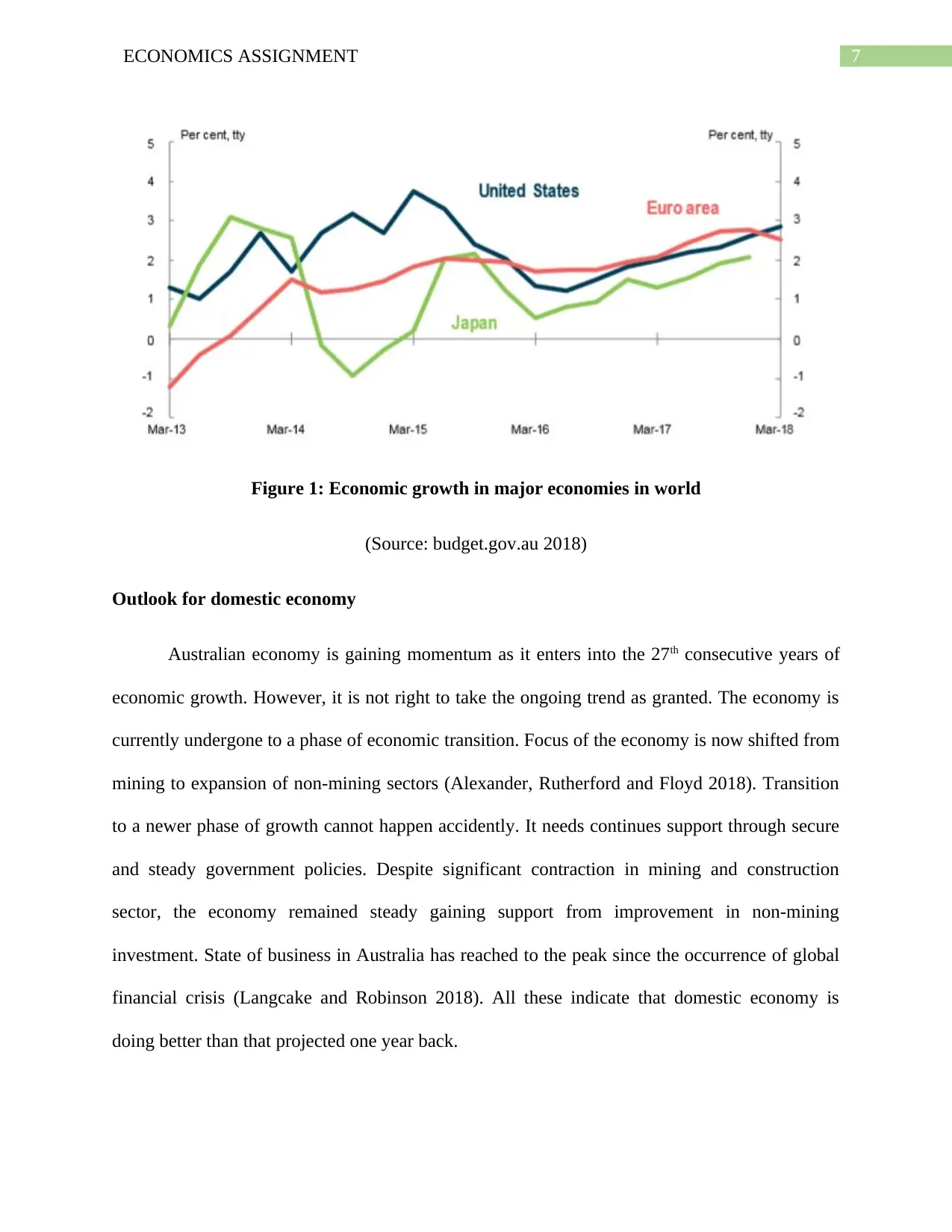
7ECONOMICS ASSIGNMENT
Figure 1: Economic growth in major economies in world
(Source: budget.gov.au 2018)
Outlook for domestic economy
Australian economy is gaining momentum as it enters into the 27th consecutive years of
economic growth. However, it is not right to take the ongoing trend as granted. The economy is
currently undergone to a phase of economic transition. Focus of the economy is now shifted from
mining to expansion of non-mining sectors (Alexander, Rutherford and Floyd 2018). Transition
to a newer phase of growth cannot happen accidently. It needs continues support through secure
and steady government policies. Despite significant contraction in mining and construction
sector, the economy remained steady gaining support from improvement in non-mining
investment. State of business in Australia has reached to the peak since the occurrence of global
financial crisis (Langcake and Robinson 2018). All these indicate that domestic economy is
doing better than that projected one year back.
Figure 1: Economic growth in major economies in world
(Source: budget.gov.au 2018)
Outlook for domestic economy
Australian economy is gaining momentum as it enters into the 27th consecutive years of
economic growth. However, it is not right to take the ongoing trend as granted. The economy is
currently undergone to a phase of economic transition. Focus of the economy is now shifted from
mining to expansion of non-mining sectors (Alexander, Rutherford and Floyd 2018). Transition
to a newer phase of growth cannot happen accidently. It needs continues support through secure
and steady government policies. Despite significant contraction in mining and construction
sector, the economy remained steady gaining support from improvement in non-mining
investment. State of business in Australia has reached to the peak since the occurrence of global
financial crisis (Langcake and Robinson 2018). All these indicate that domestic economy is
doing better than that projected one year back.
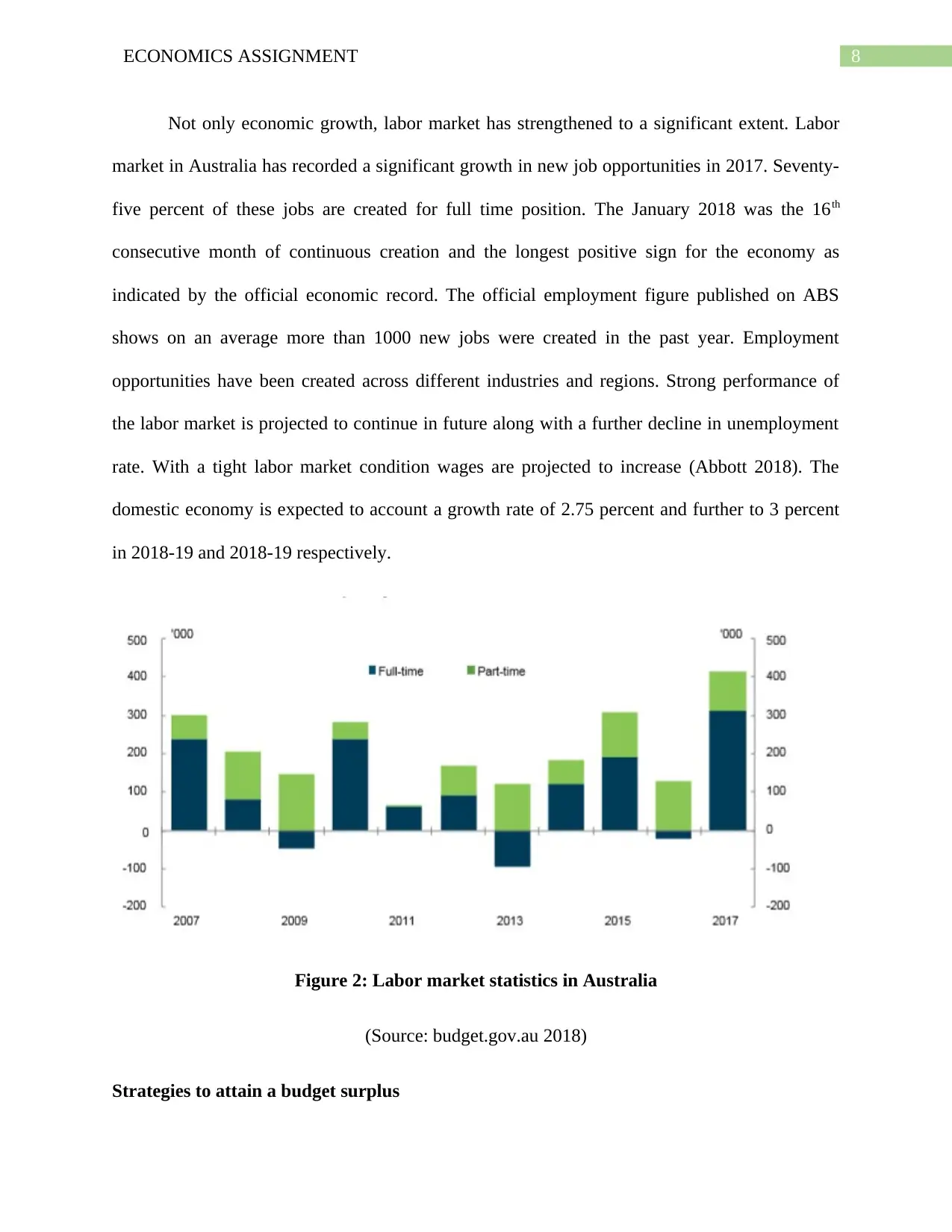
8ECONOMICS ASSIGNMENT
Not only economic growth, labor market has strengthened to a significant extent. Labor
market in Australia has recorded a significant growth in new job opportunities in 2017. Seventy-
five percent of these jobs are created for full time position. The January 2018 was the 16th
consecutive month of continuous creation and the longest positive sign for the economy as
indicated by the official economic record. The official employment figure published on ABS
shows on an average more than 1000 new jobs were created in the past year. Employment
opportunities have been created across different industries and regions. Strong performance of
the labor market is projected to continue in future along with a further decline in unemployment
rate. With a tight labor market condition wages are projected to increase (Abbott 2018). The
domestic economy is expected to account a growth rate of 2.75 percent and further to 3 percent
in 2018-19 and 2018-19 respectively.
Figure 2: Labor market statistics in Australia
(Source: budget.gov.au 2018)
Strategies to attain a budget surplus
Not only economic growth, labor market has strengthened to a significant extent. Labor
market in Australia has recorded a significant growth in new job opportunities in 2017. Seventy-
five percent of these jobs are created for full time position. The January 2018 was the 16th
consecutive month of continuous creation and the longest positive sign for the economy as
indicated by the official economic record. The official employment figure published on ABS
shows on an average more than 1000 new jobs were created in the past year. Employment
opportunities have been created across different industries and regions. Strong performance of
the labor market is projected to continue in future along with a further decline in unemployment
rate. With a tight labor market condition wages are projected to increase (Abbott 2018). The
domestic economy is expected to account a growth rate of 2.75 percent and further to 3 percent
in 2018-19 and 2018-19 respectively.
Figure 2: Labor market statistics in Australia
(Source: budget.gov.au 2018)
Strategies to attain a budget surplus
⊘ This is a preview!⊘
Do you want full access?
Subscribe today to unlock all pages.

Trusted by 1+ million students worldwide
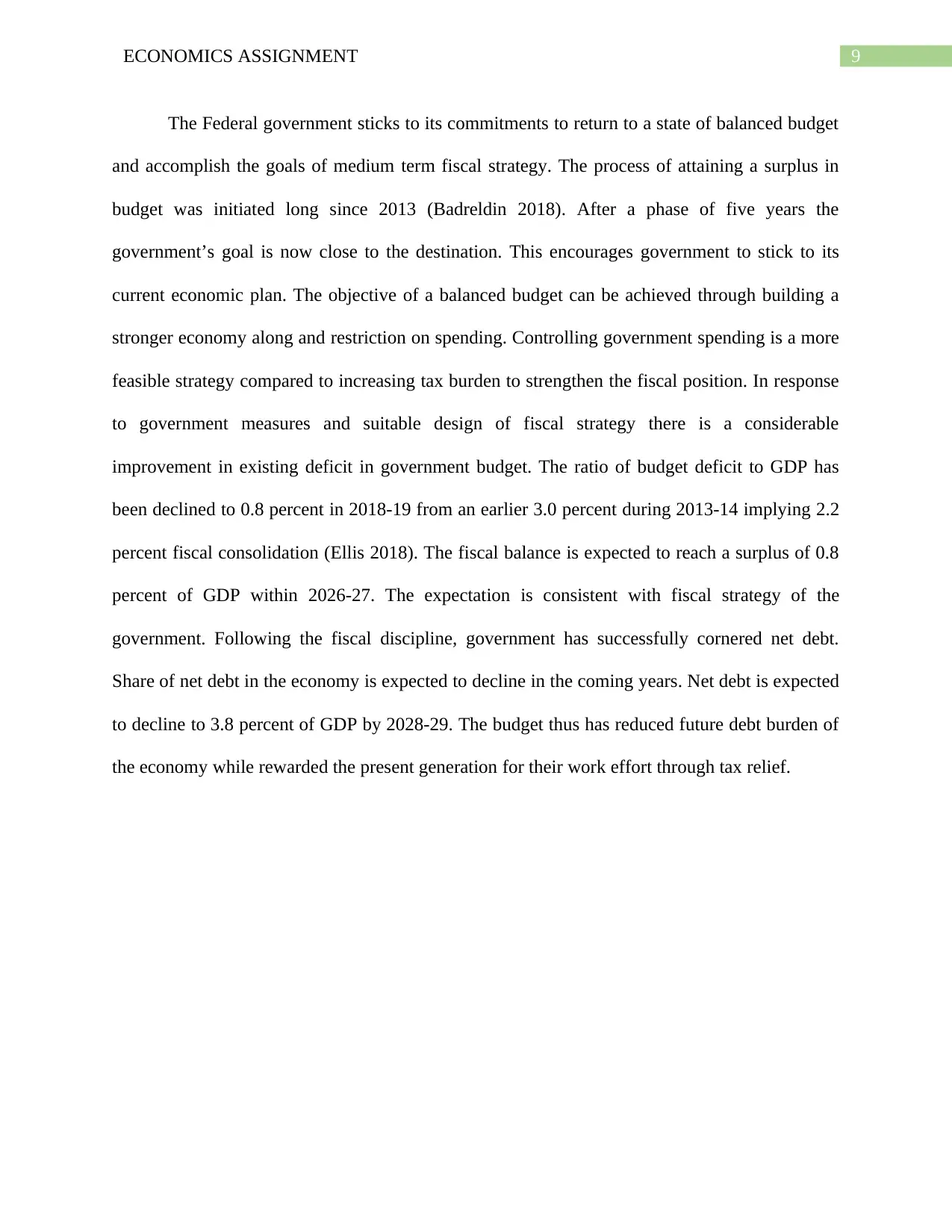
9ECONOMICS ASSIGNMENT
The Federal government sticks to its commitments to return to a state of balanced budget
and accomplish the goals of medium term fiscal strategy. The process of attaining a surplus in
budget was initiated long since 2013 (Badreldin 2018). After a phase of five years the
government’s goal is now close to the destination. This encourages government to stick to its
current economic plan. The objective of a balanced budget can be achieved through building a
stronger economy along and restriction on spending. Controlling government spending is a more
feasible strategy compared to increasing tax burden to strengthen the fiscal position. In response
to government measures and suitable design of fiscal strategy there is a considerable
improvement in existing deficit in government budget. The ratio of budget deficit to GDP has
been declined to 0.8 percent in 2018-19 from an earlier 3.0 percent during 2013-14 implying 2.2
percent fiscal consolidation (Ellis 2018). The fiscal balance is expected to reach a surplus of 0.8
percent of GDP within 2026-27. The expectation is consistent with fiscal strategy of the
government. Following the fiscal discipline, government has successfully cornered net debt.
Share of net debt in the economy is expected to decline in the coming years. Net debt is expected
to decline to 3.8 percent of GDP by 2028-29. The budget thus has reduced future debt burden of
the economy while rewarded the present generation for their work effort through tax relief.
The Federal government sticks to its commitments to return to a state of balanced budget
and accomplish the goals of medium term fiscal strategy. The process of attaining a surplus in
budget was initiated long since 2013 (Badreldin 2018). After a phase of five years the
government’s goal is now close to the destination. This encourages government to stick to its
current economic plan. The objective of a balanced budget can be achieved through building a
stronger economy along and restriction on spending. Controlling government spending is a more
feasible strategy compared to increasing tax burden to strengthen the fiscal position. In response
to government measures and suitable design of fiscal strategy there is a considerable
improvement in existing deficit in government budget. The ratio of budget deficit to GDP has
been declined to 0.8 percent in 2018-19 from an earlier 3.0 percent during 2013-14 implying 2.2
percent fiscal consolidation (Ellis 2018). The fiscal balance is expected to reach a surplus of 0.8
percent of GDP within 2026-27. The expectation is consistent with fiscal strategy of the
government. Following the fiscal discipline, government has successfully cornered net debt.
Share of net debt in the economy is expected to decline in the coming years. Net debt is expected
to decline to 3.8 percent of GDP by 2028-29. The budget thus has reduced future debt burden of
the economy while rewarded the present generation for their work effort through tax relief.
Paraphrase This Document
Need a fresh take? Get an instant paraphrase of this document with our AI Paraphraser
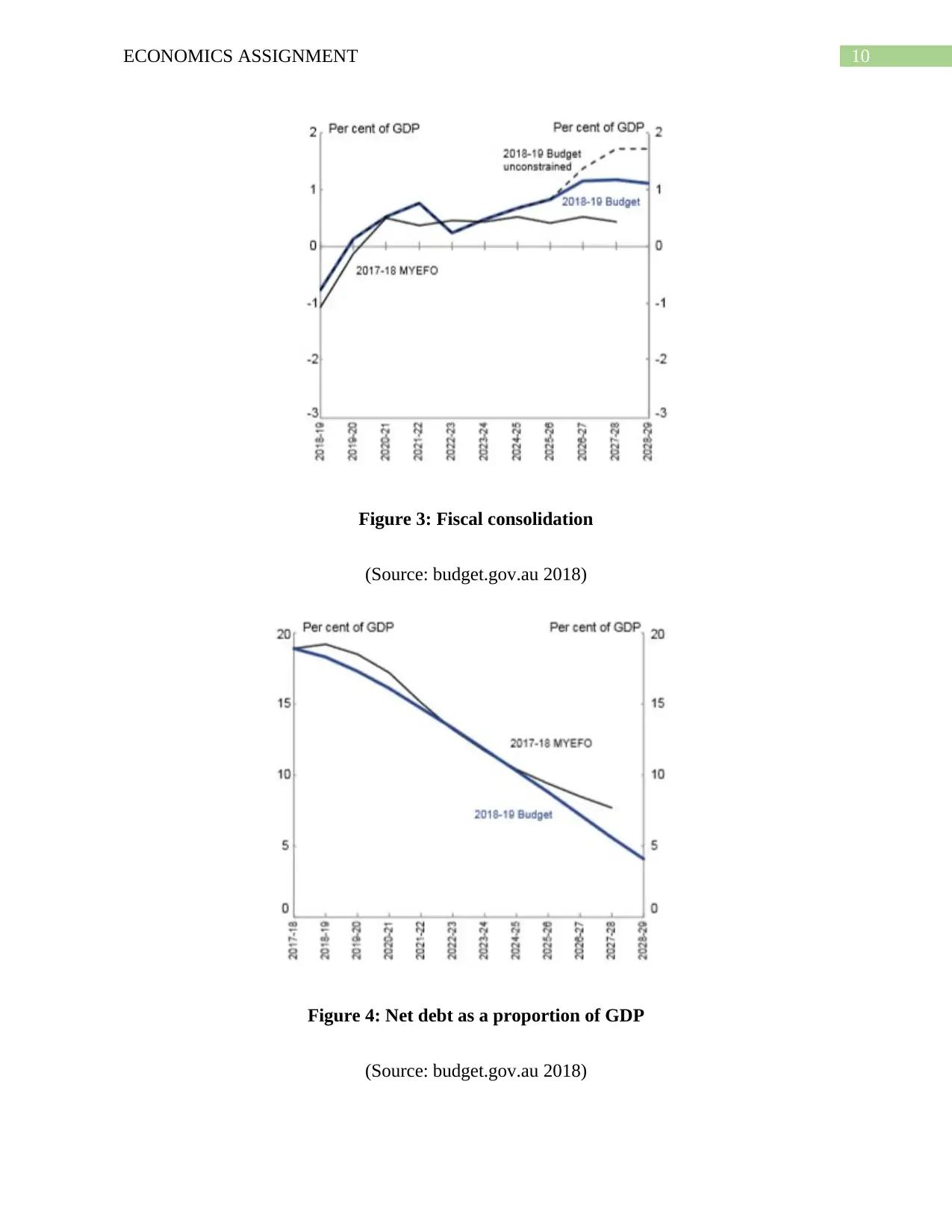
10ECONOMICS ASSIGNMENT
Figure 3: Fiscal consolidation
(Source: budget.gov.au 2018)
Figure 4: Net debt as a proportion of GDP
(Source: budget.gov.au 2018)
Figure 3: Fiscal consolidation
(Source: budget.gov.au 2018)
Figure 4: Net debt as a proportion of GDP
(Source: budget.gov.au 2018)
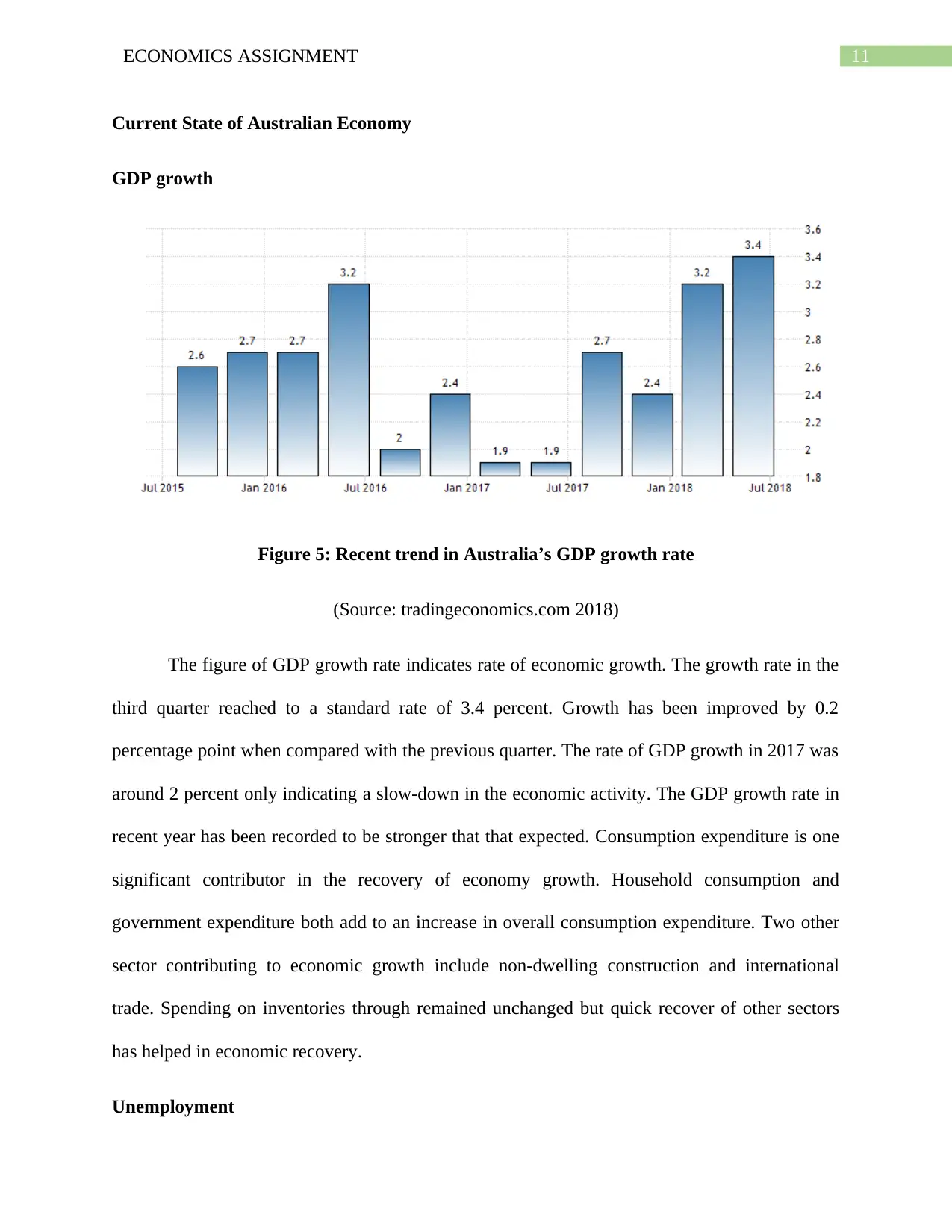
11ECONOMICS ASSIGNMENT
Current State of Australian Economy
GDP growth
Figure 5: Recent trend in Australia’s GDP growth rate
(Source: tradingeconomics.com 2018)
The figure of GDP growth rate indicates rate of economic growth. The growth rate in the
third quarter reached to a standard rate of 3.4 percent. Growth has been improved by 0.2
percentage point when compared with the previous quarter. The rate of GDP growth in 2017 was
around 2 percent only indicating a slow-down in the economic activity. The GDP growth rate in
recent year has been recorded to be stronger that that expected. Consumption expenditure is one
significant contributor in the recovery of economy growth. Household consumption and
government expenditure both add to an increase in overall consumption expenditure. Two other
sector contributing to economic growth include non-dwelling construction and international
trade. Spending on inventories through remained unchanged but quick recover of other sectors
has helped in economic recovery.
Unemployment
Current State of Australian Economy
GDP growth
Figure 5: Recent trend in Australia’s GDP growth rate
(Source: tradingeconomics.com 2018)
The figure of GDP growth rate indicates rate of economic growth. The growth rate in the
third quarter reached to a standard rate of 3.4 percent. Growth has been improved by 0.2
percentage point when compared with the previous quarter. The rate of GDP growth in 2017 was
around 2 percent only indicating a slow-down in the economic activity. The GDP growth rate in
recent year has been recorded to be stronger that that expected. Consumption expenditure is one
significant contributor in the recovery of economy growth. Household consumption and
government expenditure both add to an increase in overall consumption expenditure. Two other
sector contributing to economic growth include non-dwelling construction and international
trade. Spending on inventories through remained unchanged but quick recover of other sectors
has helped in economic recovery.
Unemployment
⊘ This is a preview!⊘
Do you want full access?
Subscribe today to unlock all pages.

Trusted by 1+ million students worldwide
1 out of 22
Related Documents
Your All-in-One AI-Powered Toolkit for Academic Success.
+13062052269
info@desklib.com
Available 24*7 on WhatsApp / Email
![[object Object]](/_next/static/media/star-bottom.7253800d.svg)
Unlock your academic potential
Copyright © 2020–2025 A2Z Services. All Rights Reserved. Developed and managed by ZUCOL.





